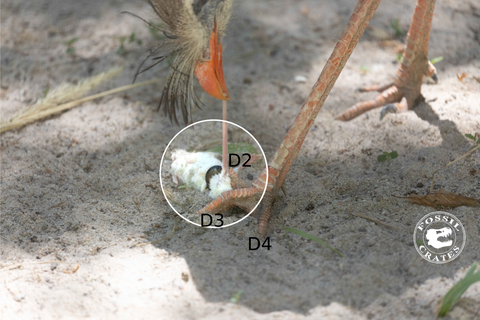
Seriema - modern day Velociraptor?
Share
Modern Day Velociraptor?

Meet the red-legged seriema, Cariama cristata. This modern South American bird is the only surviving cousin to the famed "terror birds" like Phorushacos and Titanis, apex predators that roamed South America as recently as 2 million years ago. It is also the closest living bird, claw-wise, to Velociraptor!
Like "raptor" dinosaurs (paleontologists use the term deinonychosaurs), seriemas have a giant second toe claw. Though a tad more compressed laterally, and kept off the ground by means of a foot pad instead of hyper-extended toe bones, the end result is the same: a sickle-shaped, perpetually sharp "killing claw" just like Velociraptor.

Velociraptor is often portrayed as using their 2"+ claw to slash prey open. I don't believe that is actually how it used these claws though! I was part of a team, led by Brigham Young University paleontologist Taylor Oswald, that carefully studied how seriemas use their killing claws. We built upon the work of Dr. Denver Fowler and his team, who coined the cool term RPR (pronounced 'ripper'), the Raptor Prey Restraint model for how "raptor" dinosaurs used their "killing claws".
We observed these oversized claws were *not* used to slash open prey like in the movies. Instead it was used to pin prey to the ground, while the seriema's sharp-tipped beak punched a hole into its prey. The seriema would forcefully throw its head back, taking with it a chunk of flesh.

We believe Velociraptor and its cousins, with sharply clawed hands and a mouth full of vicious teeth, dispatched prey the same way. After running down a lizard, mammal, or small dinosaur, the Velociraptor would stomp it with its foot, the "killing claw" needling the victim. As the soon-to-be meal wriggled to get free, twisting in pain from the claw tip stuck in its back, the Velociraptor bit down then ripped back with great force, tearing a chunk of flesh free. All the while it was slicing its victim open with its sharp hand claws. The "killing claw" wasn't used to slash its victim open so much as a kind of knife with its hands and teeth acting as the fork.

 Though they can fly, seriema hunt from the ground, relying on sharp senses and fleetness of foot to spot and run down food. The Mesozoic "raptors" did the same, long legs and sharp senses keeping watch for prey and long legs allowing them to run it down.
Though they can fly, seriema hunt from the ground, relying on sharp senses and fleetness of foot to spot and run down food. The Mesozoic "raptors" did the same, long legs and sharp senses keeping watch for prey and long legs allowing them to run it down.
The "killing claws" of seriema and "raptor" dinosaurs are an example of convergent evolution. In fact, within birds (aka dinosaurs), Digit II repeated becomes enlarged. There is some kind of genetic predisposition for this particular claw to become modified in birds, think of the cassowary's stiletto and the carcharodontosaurid Meraxes fascinating Digit II.

1 comment
Aha! But B.C., how does this work when applied to more macropredatory endeavors? Perhaps a precision prison shiv, as in the Fighting Dinosaurs specimen?